Ecological Footprint Accounting for Countries: Updates and Results of the National Footprint Accounts, 2012–2018
Abstract
1. Introduction
2. Materials and Methods
2.1. Accounting Framework
2.2. Basic Equations
- -
- P is the production (or harvest) in tons per year,
- -
- Yw is the world average yield in tons per hectare, per year, and
- -
- EQF is the equivalence factor.
- -
- EFP is the is the Ecological Footprint of production,
- -
- EFI is the Ecological Footprint of imports, and
- -
- EFE is the Ecological Footprint of exports.
- -
- An is the area in country “n” for this land-use category in hectares, and
- -
- Yn is the national average yield for this land-use category in tons per hectare and year.
2.3. Review of NFA Production and Updates
2.3.1. NFA Production Process
2.3.2. Previous NFA Updates
2.4. Updates and Improvements to the NFA, 2012–2018
2.4.1. Average Forest-Carbon Sequestration
2.4.2. Allocation of “Other CO2” Emissions to Countries
2.4.3. Marginal Crop-Yield Factors
2.4.4. Footprint of Fishing Grounds
2.4.5. Other Updates
3. Results
3.1. Accounting Improvements, NFA Editions 2012–2018
3.2. National Footprint Accounts, 2018 Edition
3.2.1. Global Trends
3.2.2. Regional Trends
3.2.3. Sustainable Development Trends
4. Discussion
4.1. Ecological Footprint Accounting Improvements
4.2. Ecological Footprint and Biocapacity Trends
4.3. Relevance of National Footprint Accounts to Global Sustainability
4.4. Applications of National Footprint Accounts
4.5. Looking Forward: The Future of National Footprint Accounts
Author Contributions
Funding
Acknowledgments
Conflicts of Interest
References
- World Commission on Environment and Development. Our Common Future; World Commission on Environment and Development: Oxford, UK, 1987. [Google Scholar]
- Sala, S.; Farioli, F.; Zamagni, A. Progress in sustainability science: Lessons learnt from current methodologies for sustainability assessment: Part 1. Int. J. Life Cycle Assess. 2013, 18, 1653–1672. [Google Scholar] [CrossRef]
- McMichael, A.J.; Butler, C.D.; Folke, C. New Visions for Addressing Sustainability. Science 2003, 302, 1919–1920. [Google Scholar] [CrossRef] [PubMed]
- Pulselli, F.M.; Moreno Pires, S.; Galli, A. The Need for an Integrated Assessment Framework to Account for Humanity’s Pressure on the Earth System. In The Safe Operating Space Treaty: A New Approach to Managing Our Use of the Earth System; Magalhães, P., Steffen, W., Bosselmann, K., Aragão, A., Soromenho-Marques, V., Eds.; Cambridge Scholars Publishing: Cambridge, UK, 2016; pp. 213–245. [Google Scholar]
- Costanza, R.; McGlade, J.; Lovins, H.; Kubiszewski, I. An Overarching Goal for the UN Sustainable Development Goals. Solutions 2014, 5, 13–16. [Google Scholar]
- United Nations Agenda. Chapter 40: Information for Decision-Making; United Nations Agenda: Rio de Janerio, Brazil, 1992; pp. 346–351. [Google Scholar]
- Wackernagel, M.; Galli, A.; Hanscom, L.; Lin, D.; Mailhes, L.; Drummond, T. Chapter 16: Ecological Footprint Accounts: Principles. In Routledge Handbook of Sustainability Indictors; Bell, S., Morse, S., Eds.; Routledge International Handbooks; Routledge: Abingdon, UK, 2018; pp. 244–264. [Google Scholar]
- Wackernagel, M.; Galli, A.; Hanscom, L.; Lin, D.; Mailhes, L.; Drummond, T. Chapter 33: Ecological Footprint Accounts: Criticisms and Applications. In Routledge Handbook of Sustainability Indictors; Bell, S., Morse, S., Eds.; Routledge International Handbooks; Routledge: Abingdon, UK, 2018; pp. 521–539. [Google Scholar]
- Mancini, M.S.; Galli, A.; Coscieme, L.; Niccolucci, V.; Lin, D.; Pulselli, F.M.; Bastianoni, S.; Marchettini, N. Exploring ecosystem services assessment through Ecological Footprint accounting. Ecosyst. Serv. 2018, 30, 228–235. [Google Scholar] [CrossRef]
- Galli, A.; Wackernagel, M.; Iha, K.; Lazarus, E. Ecological Footprint: Implications for biodiversity. Biol. Conserv. 2014, 173, 121–132. [Google Scholar] [CrossRef]
- Steffen, W.; Richardson, K.; Rockström, J.; Cornell, S.E.; Fetzer, I.; Bennett, E.M.; Biggs, R.; Carpenter, S.R.; de Vries, W.; de Wit, C.A.; et al. Planetary boundaries: Guiding human development on a changing planet. Science 2015, 347, 1259855. [Google Scholar] [CrossRef] [PubMed]
- Sala, S.; Ciuffo, B.; Nijkamp, P. A systemic framework for sustainability assessment. Ecol. Econ. 2015, 119, 314–325. [Google Scholar] [CrossRef]
- Wackernagel, M.; Onisto, L.; Linares, A.C.; Falfan, I.S.L.; Garcia, J.M.; Guerrero, A.I.S.; Guerrero, M.G.S. Ecological footprints of nations: How much nature do they use? How much nature do they have? In Commissioned by the Earth Council for the Rio+5 Forum; UNEP: Toronto, ON, Canada, 1997. [Google Scholar]
- Wackernagel, M.; Onisto, L.; Bello, P.; Linares, A.C.; Falfán, I.S.L.; Garcıa, J.M.; Guerrero, A.I.S.; Guerrero, M.G.S. National natural capital accounting with the ecological footprint concept. Ecol. Econ. 1999, 29, 375–390. [Google Scholar] [CrossRef]
- Wackernagel, M.; Rees, W. Our Ecological Footprint: Reducing Human Impact on the Earth; New Society Publishers: Gabriola Island, BC, Canada, 1996; ISBN 978-0-86571-312-3. [Google Scholar]
- Borucke, M.; Moore, D.; Cranston, G.; Gracey, K.; Iha, K.; Larson, J.; Lazarus, E.; Morales, J.C.; Wackernagel, M.; Galli, A. Accounting for demand and supply of the biosphere’s regenerative capacity: The National Footprint Accounts’ underlying methodology and framework. Ecol. Indic. 2013, 24, 518–533. [Google Scholar] [CrossRef]
- Lazarus, E.; Zokai, G.; Borucke, M.; Panda, D.; Iha, K.; Morales, J.C.; Wackernagel, M.; Galli, A.; Gupta, N. Working Guidebook to the National Footprint Accounts, 2014th ed.; Global Footprint Network: Oakland, CA, USA, 2014. [Google Scholar]
- Global Footprint Network. National Footprint Accounts, 2018th ed.; Global Footprint Network: Oakland, CA, USA, 2018. [Google Scholar]
- Wackernagel, M.; Schulz, N.B.; Deumling, D.; Linares, A.C.; Jenkins, M.; Kapos, V.; Monfreda, C.; Loh, J.; Myers, N.; Norgaard, R. Tracking the ecological overshoot of the human economy. Proc. Natl. Acad. Sci. USA 2002, 99, 9266–9271. [Google Scholar] [CrossRef] [PubMed]
- Daly, H.E. Toward some operational principles of sustainable development. Ecol. Econ. 1990, 2, 1–6. [Google Scholar] [CrossRef]
- Galli, A. On the rationale and policy usefulness of Ecological Footprint Accounting: The case of Morocco. Environ. Sci. Policy 2015, 48, 210–224. [Google Scholar] [CrossRef]
- Wackernagel, M. Land Use: Measuring a Community’s Appropriated Carrying Capacity as an Indicator for Sustainability and Using Appropriated Carrying Capacity as an Indicator, Measuring the Sustainability of a Community; Report I and II to the UBC Task Force on Healthy and Sustainable Communities; The University of British Columbia: Vancouver, BC, Canada, 1991. [Google Scholar]
- Wackernagel, M. Ecological Footprint and Appropriated Carrying Capacity: A Tool for Planning Toward Sustainability. Ph.D. Thesis, School of Community and Regional Planning, University of British Columbia, Vancouver, BC, Canada, 1994. [Google Scholar]
- Kitzes, J.; Galli, A.; Bagliani, M.; Barrett, J.; Dige, G.; Ede, S.; Erb, K.; Giljum, S.; Haberl, H.; Hails, C.; et al. A research agenda for improving national Ecological Footprint accounts. Ecol. Econ. 2009, 68, 1991–2007. [Google Scholar] [CrossRef]
- Jóhannesson, S.; Heinonen, J.; Davidsdottir, B. Increasing the Accuracy of Marine Footprint Calculations. Environ. Res. Lett. 2018, in press. [Google Scholar]
- Talberth, J.; Wolowicz, K.; Venetoulis, J.; Gelobter, M.; Boyle, P.; Mott, B. The Ecological Fishprint of Nations: Measuring Humanity’s Impact on Marine Ecosystems; Redefining Progress: Oakland, CA, USA, 2006; pp. 1–12. [Google Scholar]
- Wiedmann, T.; Lenzen, M. On the conversion between local and global hectares in Ecological Footprint analysis. Ecol. Econ. 2007, 60, 673–677. [Google Scholar] [CrossRef]
- Galli, A.; Giampietro, M.; Goldfinger, S.; Lazarus, E.; Lin, D.; Saltelli, A.; Wackernagel, M.; Müller, F. Questioning the Ecological Footprint. Ecol. Indic. 2016, 69, 224–232. [Google Scholar] [CrossRef]
- Galli, A.; Kitzes, J.; Wermer, P.; Wackernagel, M.; Niccolucci, V.; Tiezzi, E. An Exploration of the Mathematics behind the Ecological Footprint. Int. J. Ecodyn. 2007, 2, 250–257. [Google Scholar] [CrossRef]
- Lin, D.; Galli, A.; Borucke, M.; Lazarus, E.; Grunewald, N.; Martindill, J.; Zimmerman, D.; Mancini, S.; Iha, K.; Wackernagel, M. Tracking supply and demand of biocapacity through ecological footprint accounting. Sustain. Assess. Renew. Prod. Methods Case Stud. 2016, 179–200. [Google Scholar] [CrossRef]
- Lin, D.; Hanscom, L.; Martindill, J.; Borucke, M.; Cohen, L.; Galli, A.; Lazarus, E.; Zokai, G.; Iha, K.; Wackernagel, M. Working Guidebook to the National Footprint Accounts, Version 1.2; Global Footprint Network: Oakland, CA, USA, 2018. [Google Scholar]
- Monfreda, C.; Wackernagel, M.; Deumling, D. Establishing national natural capital accounts based on detailed Ecological Footprint and biological capacity assessments. Land Use Policy 2004, 21, 231–246. [Google Scholar] [CrossRef]
- Wackernagel, M.; Monfreda, C.; Schulz, N.B.; Erb, K.-H.; Haberl, H.; Krausmann, F. Calculating national and global ecological footprint time series: Resolving conceptual challenges. Land Use Policy 2004, 21, 271–278. [Google Scholar] [CrossRef]
- Wackernagel, M.; Monfreda, C.; Moran, D.; Wermer, P.; Goldfinger, S.; Deumling, D.; Murray, M. National Footprint and Biocapacity Accounts 2005: The Underlying Calculation Method; Global Footprint Network: Oakland, CA, USA, 2005; p. 33. [Google Scholar]
- Wackernagel, M.; Lewan, L.; Hansson, C.B. Evaluating the Use of Natural Capital with the Ecological Footprint: Applications in Sweden and Subregions. Ambio 1999, 28, 604–612. [Google Scholar]
- Kitzes, J.; Galli, A.; Wackernagel, M.; Goldfinger, S.; Bastianoni, S. A ‘Constant Global Hectare’ Method for Representing Ecological Footprint Time Trends. Available online: http://www.brass.cf.ac.uk/uploads/fullpapers/Kitzes_M66.pdf (accessed on 6 June 2018).
- Turner, K.; Lenzen, M.; Wiedmann, T.; Barrett, J. Examining the global environmental impact of regional consumption activities, Part 1: A technical note on combining input-output and ecological footprint analysis. Ecol. Econ. 2007, 62, 37–44. [Google Scholar] [CrossRef]
- Lin, D.; Iha, K.; Neill, E.; Hanscom, L.; Evans, M.; Murthy, A.; Martindill, J.; Wackernagel, M. Quantifying the Ecological Footprint of countries by individual consumption category: The Consumption Land Use Matrix (CLUM). 2018; in press. [Google Scholar]
- Mancini, M.S.; Galli, A.; Niccolucci, V.; Lin, D.; Bastianoni, S.; Wackernagel, M.; Marchettini, N. Ecological Footprint: Refining the carbon Footprint calculation. Ecol. Indic. 2016, 61, 390–403. [Google Scholar] [CrossRef]
- Mancini, M.S.; Galli, A.; Niccolucci, V.; Lin, D.; Hanscom, L.; Wackernagel, M.; Bastianoni, S.; Marchettini, N. Stocks and flows of natural capital: Implications for Ecological Footprint. Ecol. Indic. 2017, 77, 123–128. [Google Scholar] [CrossRef]
- Mancini, M.; Evans, M.; Iha, K.; Danelutti, C.; Galli, A.; Mancini, M.S.; Evans, M.; Iha, K.; Danelutti, C.; Galli, A. Assessing the Ecological Footprint of Ecotourism Packages: A Methodological Proposition. Resources 2018, 7, 38. [Google Scholar] [CrossRef]
- Weinzettel, J.; Steen-Olsen, K.; Hertwich, E.G.; Borucke, M.; Galli, A. Ecological footprint of nations: Comparison of process analysis, and standard and hybrid multiregional input–output analysis. Ecol. Econ. 2014, 101, 115–126. [Google Scholar] [CrossRef]
- Galli, A.; Iha, K.; Halle, M.; El Bilali, H.; Grunewald, N.; Eaton, D.; Capone, R.; Debs, P.; Bottalico, F. Mediterranean countries’ food consumption and sourcing patterns: An Ecological Footprint viewpoint. Sci. Total Environ. 2017, 578, 383–391. [Google Scholar] [CrossRef] [PubMed]
- International Energy Agency World. CO2 Emissions from Fuel Combustion; Database Documentation; Organization for Economic: Paris, France, 2015. [Google Scholar]
- Ritchie, H.; Roser, M. Energy Production & Changing Energy Sources; Our World in Data; Island Press: Washington, DC, USA, 2018. [Google Scholar]
- Galli, A.; Kitzes, J.; Niccolucci, V.; Wackernagel, M.; Wada, Y.; Marchettini, N. Assessing the global environmental consequences of economic growth through the Ecological Footprint: A focus on China and India. Ecol. Indic. 2012, 17, 99–107. [Google Scholar] [CrossRef]
- United Nations Development Programme. 2016 Human Development Report; United Nations Development Programme: New York, NY, USA, 2016. [Google Scholar]
- Wilting, H.C.; Schipper, A.M.; Bakkenes, M.; Meijer, J.R.; Huijbregts, M.A.J. Quantifying Biodiversity Losses Due to Human Consumption: A Global-Scale Footprint Analysis. Environ. Sci. Technol. 2017, 51, 3298–3306. [Google Scholar] [CrossRef] [PubMed]
- Food and Agriculture Organization of the United Nations (FAO). The State of World Fisheries and Aquaculture; Food and Agriculture Organization of the United Nations: Rome, Italy, 2014; pp. 3–93. [Google Scholar]
- Verones, F.; Moran, D.; Stadler, K.; Kanemoto, K.; Wood, R. Resource footprints and their ecosystem consequences. Sci. Rep. 2017, 7, 40743. [Google Scholar] [CrossRef] [PubMed]
- Venter, O.; Sanderson, E.W.; Magrach, A.; Allan, J.R.; Beher, J.; Jones, K.R.; Possingham, H.P.; Laurance, W.F.; Wood, P.; Fekete, B.M.; et al. Sixteen years of change in the global terrestrial human footprint and implications for biodiversity conservation. Nat. Commun. 2016, 7, 1–11. [Google Scholar] [CrossRef] [PubMed]
- Butchart, S.H.M.; Walpole, M.; Collen, B.; van Strien, A.; Scharlemann, J.P.W.; Almond, R.E.A.; Baillie, J.E.M.; Bomhard, B.; Brown, C.; Bruno, J.; et al. Global Biodiversity: Indicators of Recent Declines. Science 2010, 1187512. [Google Scholar] [CrossRef] [PubMed]
- D’Odorico, P.; Frankel Davis, K.; Rosa, L.; Carr, J.A.; Chiarelli, D.; Dell’Angelo, J.; Gephart, J.; MacDonald, G.K.; Seekell, D.A.; Suwels, S.; et al. Environmental Policy Analysis The Global Food-Energy-Water Nexus. Rev. Geophys. 2018, 56. [Google Scholar] [CrossRef]
- United Nations, Department of Economic and Social Affairs, Population Division. World Population Prospects: The 2017 Revision, Key Findings and Advance Tables; United Nations, Department of Economic and Social Affairs, Population Division: New York, NY, USA, 2017. [Google Scholar]
- Niccolucci, V.; Pulselli, F.M.; Tiezzi, E. Strengthening the threshold hypothesis: Economic and biophysical limits to growth. Ecol. Econ. 2007, 60, 667–672. [Google Scholar] [CrossRef]
- Bastianoni, S.; Niccolucci, V.; Neri, E.; Cranston, G.; Galli, A.; Wackernagel, M. Sustainable Development: Ecological Footprint in Accounting. Encycl. Environ. Manag. 2013, 2467–2481. [Google Scholar] [CrossRef]
- Galli, A.; Halle, M.; Grunewald, N. Physical limits to resource access and utilisation and their economic implications in Mediterranean economies. Environ. Sci. Policy 2015, 51, 125–136. [Google Scholar] [CrossRef]
- Rudolph, A.; Figge, L. Determinants of Ecological Footprints: What is the role of globalization? Ecol. Indic. 2017, 81, 348–361. [Google Scholar] [CrossRef]
- Ulucak, R.; Lin, D. Persistence of policy shocks to Ecological Footprint of the USA. Ecol. Indic. 2017, 80, 337–343. [Google Scholar] [CrossRef]
- Charfeddine, L.; Mrabet, Z. The impact of economic development and social-political factors on ecological footprint: A panel data analysis for 15 MENA countries. Renew. Sustain. Energy Rev. 2017, 76, 138–154. [Google Scholar] [CrossRef]
- Wilson, E.O. Half-Earth: Our Planet’s Fight for Life; Liveright Publishing Corporation: New York, NY, USA, 2016; ISBN 978-1-63149-082-8. [Google Scholar]
- Wackernagel, M.; Hanscom, L.; Lin, D. Making the Sustainable Development Goals Consistent with Sustainability. Front. Energy Res. 2017, 5. [Google Scholar] [CrossRef]
- Search Results of “National Footprint Accounts” in Google Scholar. Available online: https://scholar.google.com/scholar?hl=en&as_sdt=1%2C5&as_ylo=2013&q=%22National+Footprint+Accounts%22 (accessed on 7 September 2018).
- Search Results of “Ecological Footprint” in Google Scholar. Available online: http://scholar.google.com/scholar?hl=en&as_sdt=1%2C5&as_ylo=2013&q=Ecological+footprint (accessed on 7 September 2018).
- Meltwater. Available online: www.meltwater.com (accessed on 28 August 2018).
- Collins, A.; Galli, A.; Patrizi, N.; Pulselli, F.M. Learning and teaching sustainability: The contribution of Ecological Footprint calculators. J. Clean. Prod. 2018, 174, 1000–1010. [Google Scholar] [CrossRef]
- Wackernagel, M.; Galli, A.; Borucke, M.; Lazarus, E.; Mattoon, S. Ecological footprint accounting. In Globalisation, Economic Transition and the Environment: Forging a Path to Sustainable Development; Lawn, P., Ed.; Edward Elgar Publishing: Cheltenham, UK, 2013; ISBN 978-1-78195-141-5. [Google Scholar]
- Abdullatif, L.; Alam, T. UAE Ecological Footprint Initiative; WWF-EWS: Abu Dhabi, UAE, 2011. [Google Scholar]
- Galli, A.; Đurović, G.; Hanscom, L.; Knežević, J. Think globally, act locally: Implementing the sustainable development goals in Montenegro. Environ. Sci. Policy 2018, 84, 159–169. [Google Scholar] [CrossRef]
- United Nations Development Programme. National Human Development Report, Montenegro: Resource Efficiency and Sustainable Human Development; United Nations Development Programme: Podgorica, Montenegro, 2014. [Google Scholar]
- Global Footprint Network; United Nations Development Programme. Resource Constraints and Economic Performance in Eastern Europe and Central Asia; Report to UNDP Bratislava; United Nations Development Programme: Bratislava, Slovakia, 2011. [Google Scholar]
- United Nations. Conference of Parties to the Convention on Biological Diversity Indicators for the Strategic Plan for Biodiversity 2011–2020 and the Aichi Biodiversity Targets. In Proceedings of the Thirteenth Meeting, Cancun, Mexico, 2–17 December 2016; p. 24. [Google Scholar]
- Intergovernmental Science-Policy Platform on Biodiversity and Ecosystem Services (IPBES) Core indicators. Available online: https://www.ipbes.net/core-indicators (accessed on 8 September 2018).
- WWF France; Global Footprint Network. L’Autre Deficit de la France; WWF France: Le Pré St Gervais, France, 2018; p. 28. [Google Scholar]
- Boev, P.; Burenko, D.; Shvarts, E.; Diep, A.; Hanscom, L.; Iha, K.; Kelly, R.; Martindill, J.; Wackernagel, M.; Zokai, G. Ecological Footprint of the Russian Regions; WWF Russia: Moscow, Russia, 2016; p. 112. [Google Scholar]
- WWF. Living Planet Report 2016: Risk and Resilience in a New Era; WWF International: Gland, Switzerland, 2016. [Google Scholar]
- WWF Korea; Global Footprint Network. Korea Ecological Footprint Report 2016: Measuring Korea’s Impact on Nature; WWF Korea: Seoul, Korea, 2016; p. 28. [Google Scholar]
- Gaodi, X.; Shuyan, C.; Qisen, Y.; Lin, X.; Zhiyong, F.; Ying, G.; Lin, D.; Kelly, R.; Liqiang, G.; Humphrey, S. Living Planet Report, China 2015: Development, Species and Ecological Civilization; WWF China: Beijing, China, 2015; p. 82. [Google Scholar]
- United Nations Environment Programme Finance Initiative; Global Footprint Network. A New Angle on Sovereign Credit Risk, E-RISC: Environmental Risk Integration in Sovereign Credit Analysis; UNEP: Toronto, ON, Canada, 2012; p. 40. [Google Scholar]
- United Nations Environment Programme Finance Initiative; Global Footprint Network. ERISC PHASE II: How Food Prices Link Environmental Constraints to Sovereign Credit Risk; UNEP: Toronto, ON, Canada, 2016; p. 28. [Google Scholar]
- Burns, S.; Alexeyev, J.; Kelly, R.; Lin, D. Carbon Disclosure and Climate Risk in Sovereign Bonds; Global Footprint Network: Oakland, CA, USA, 2016. [Google Scholar]
- Baabou, W.; Grunewald, N.; Ouellet-Plamondon, C.; Gressot, M.; Galli, A. The Ecological Footprint of Mediterranean cities: Awareness creation and policy implications. Environ. Sci. Policy 2017, 69, 94–104. [Google Scholar] [CrossRef]
- Isman, M.; Archambault, M.; Racette, P.; Konga, C.N.; Llaque, R.M.; Lin, D.; Iha, K.; Ouellet-Plamondon, C.M. Ecological Footprint assessment for targeting climate change mitigation in cities: A case study of 15 Canadian cities according to census metropolitan areas. J. Clean. Prod. 2018, 174, 1032–1043. [Google Scholar] [CrossRef]
- OECD Stat National Accounts: 5. Final Consumption Expenditure of Households. Available online: https://stats.oecd.org/Index.aspx?DataSetCode=SNA_TABLE5 (accessed on 8 September 2018).
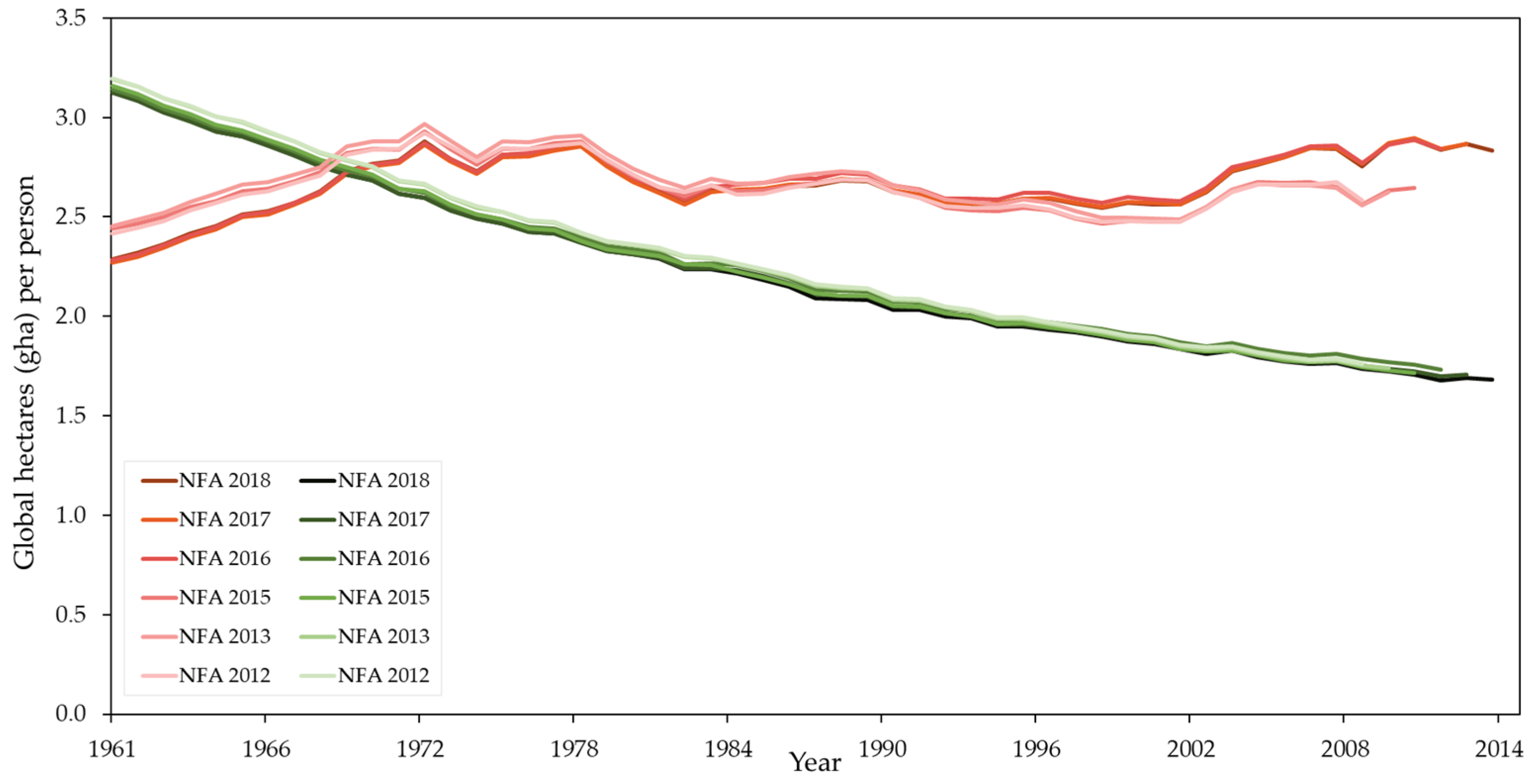
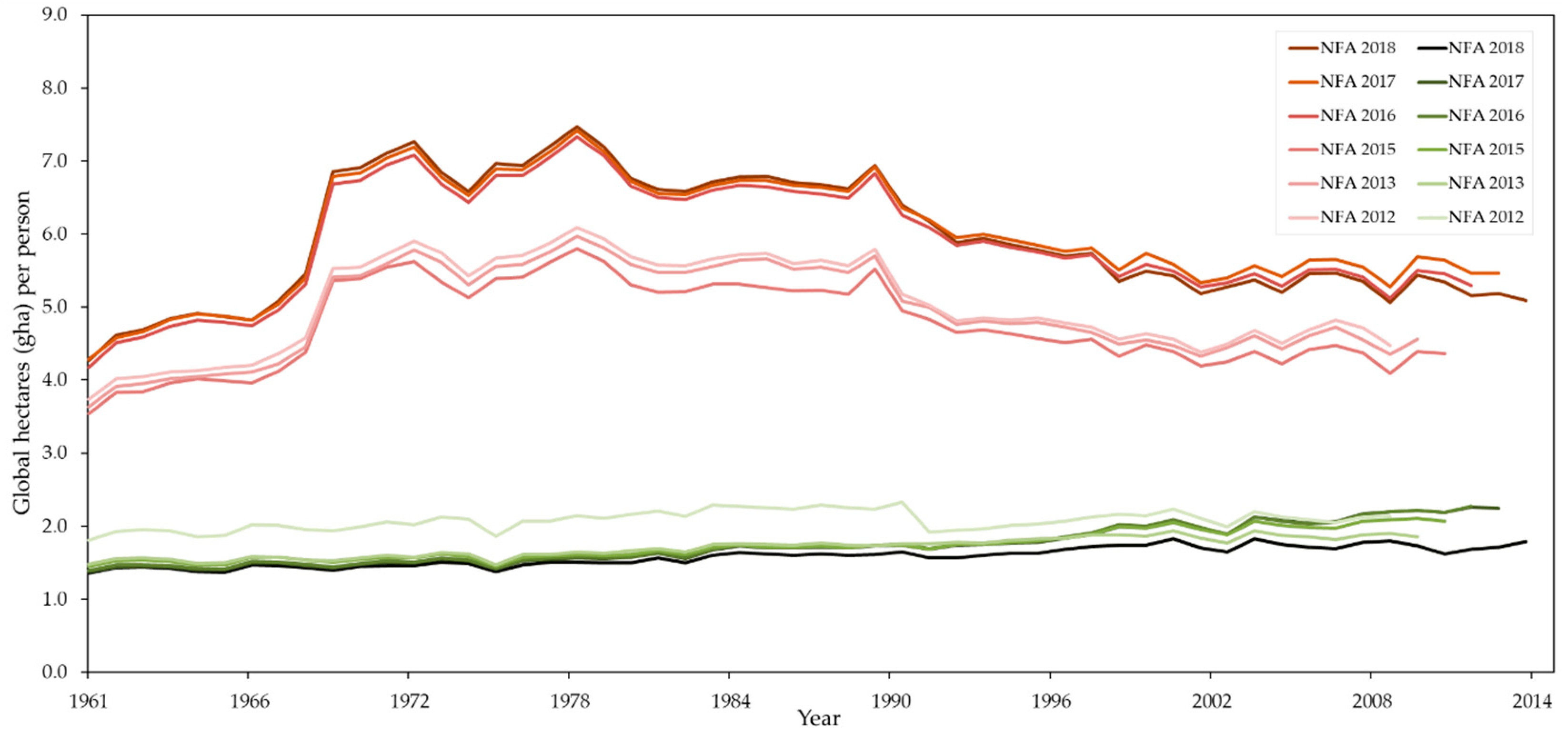
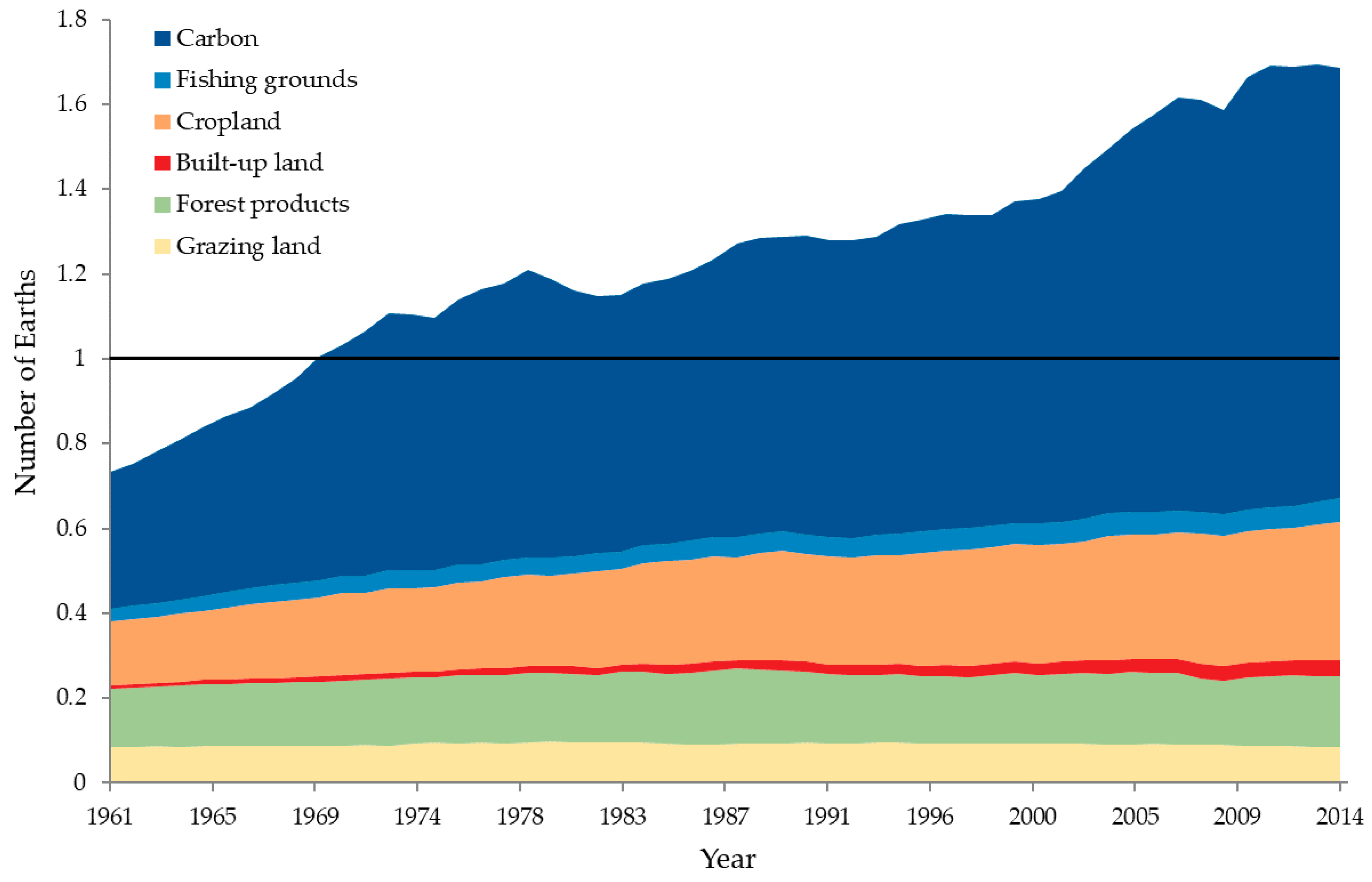
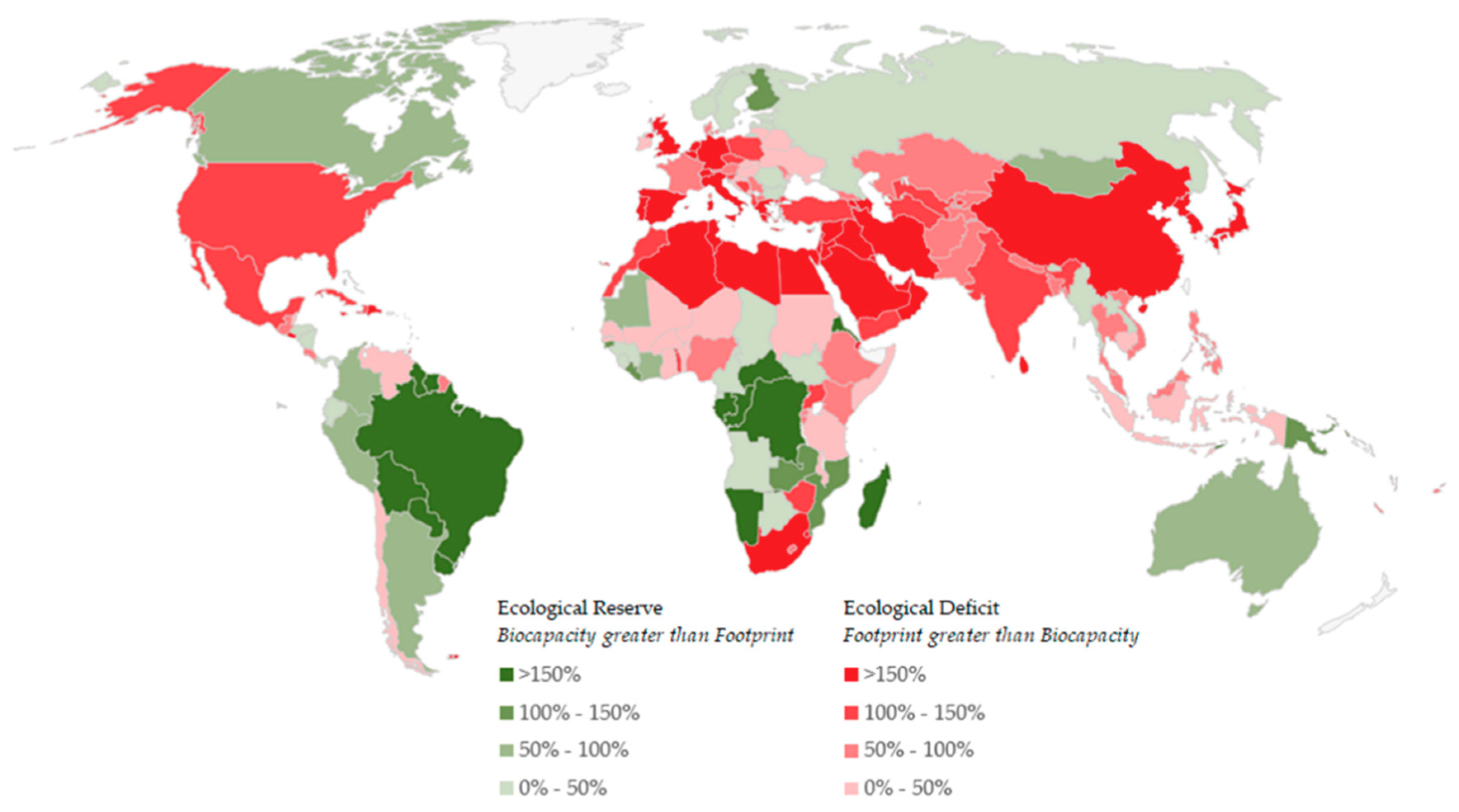
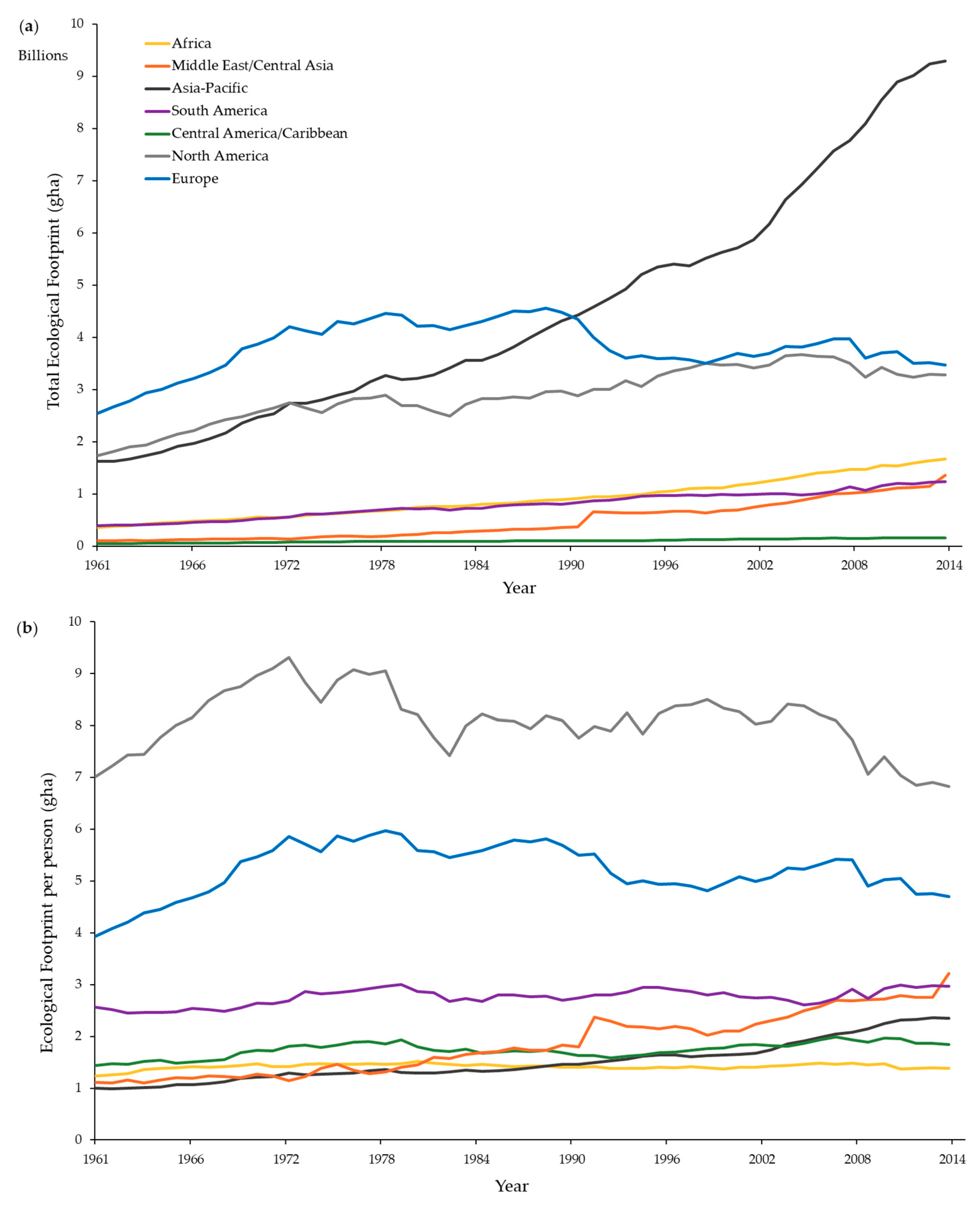
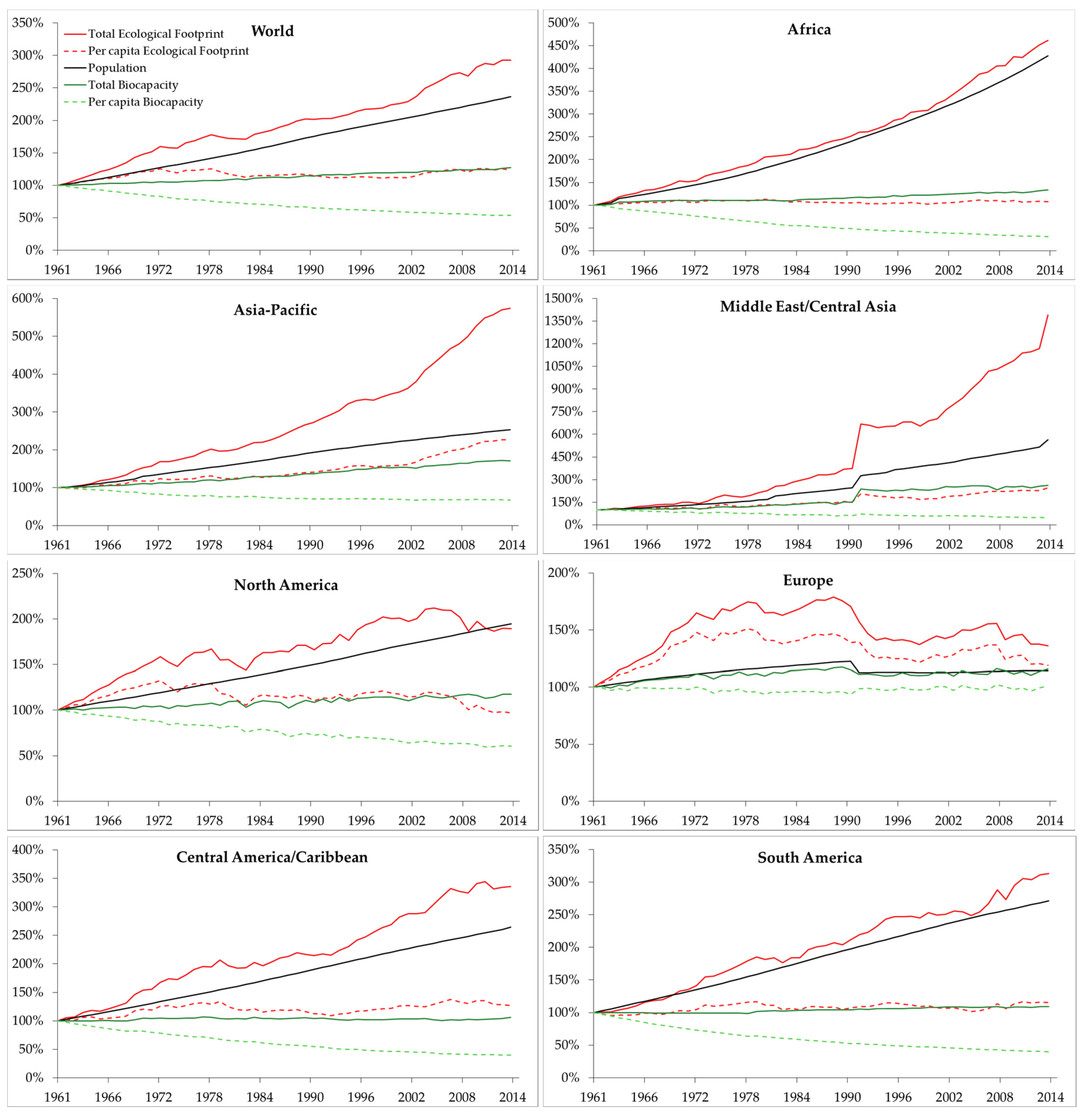
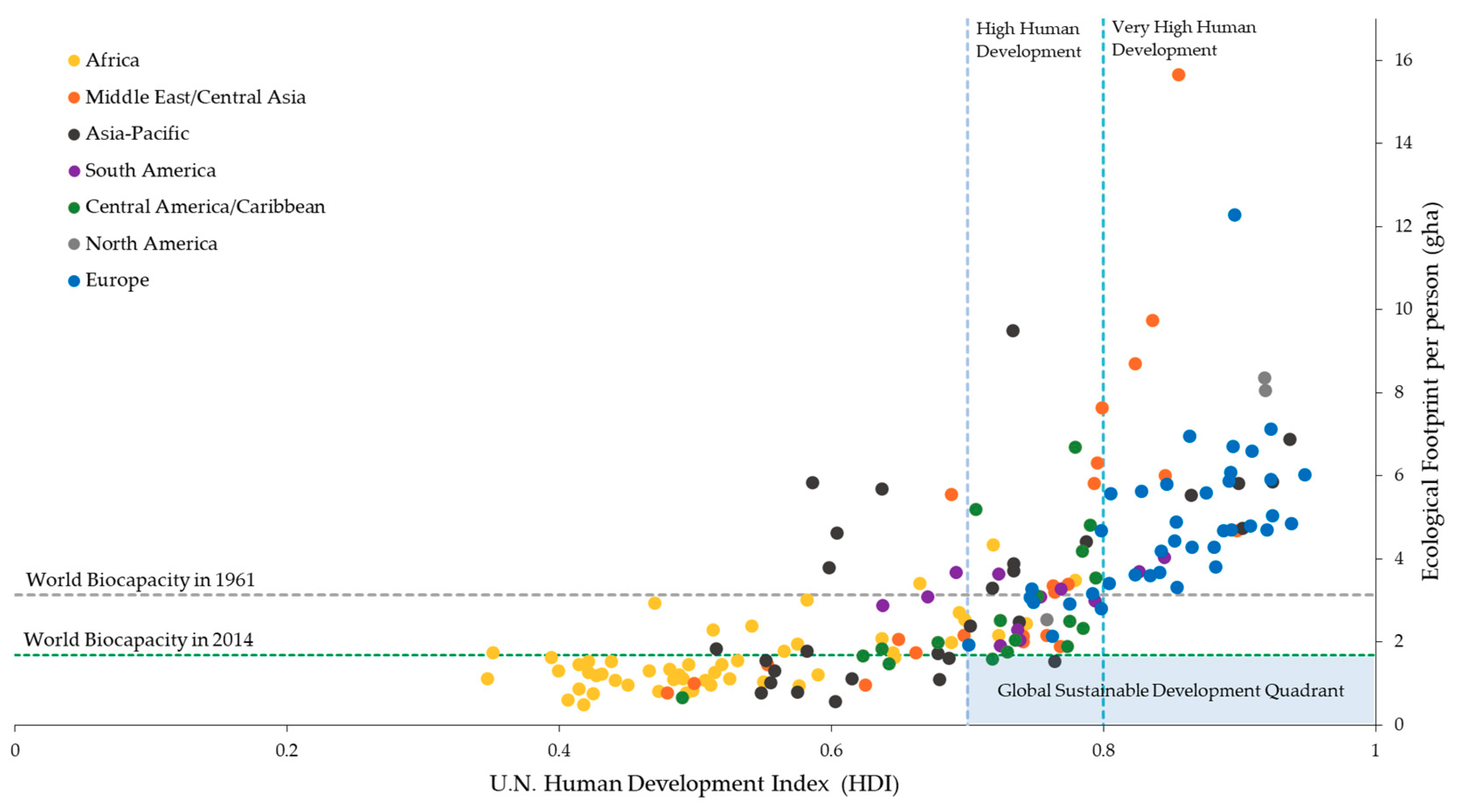
| (a) | Ecological Footprint, gha (per capita) | |||||||
| Edition | Year | Cropland | Grazing Land | Forests | Fishing Grounds | Built-Up Land | Carbon | Total |
| NFA 2012 | 2008 | 0.597 | 0.230 | 0.264 | 0.104 | 0.068 | 1.414 | 2.676 |
| NFA 2013 | 2008 | 0.573 | 0.230 | 0.266 | 0.098 | 0.063 | 1.416 | 2.646 |
| NFA 2015 | 2008 | 0.569 | 0.216 | 0.275 | 0.086 | 0.070 | 1.435 | 2.650 |
| NFA 2016 | 2008 | 0.582 | 0.168 | 0.279 | 0.090 | 0.064 | 1.674 | 2.857 |
| NFA 2017 | 2008 | 0.554 | 0.168 | 0.279 | 0.090 | 0.061 | 1.695 | 2.847 |
| NFA 2018 | 2008 | 0.542 | 0.158 | 0.279 | 0.090 | 0.060 | 1.715 | 2.844 |
| Change from NFA 2012–2018 | 2008 | −0.056 | −0.071 | 0.015 | −0.014 | −0.008 | 0.301 | 0.167 |
| (b) | Biocapacity, gha (per capita) | |||||||
| Edition | Year | Cropland | Grazing Land | Forests | Fishing Grounds | Built-Up Land | Total | |
| NFA 2012 | 2008 | 0.576 | 0.230 | 0.756 | 0.157 | 0.068 | 1.787 | |
| NFA 2013 | 2008 | 0.573 | 0.230 | 0.756 | 0.157 | 0.063 | 1.780 | |
| NFA 2015 | 2008 | 0.569 | 0.216 | 0.766 | 0.154 | 0.070 | 1.773 | |
| NFA 2016 | 2008 | 0.582 | 0.228 | 0.777 | 0.162 | 0.064 | 1.813 | |
| NFA 2017 | 2008 | 0.554 | 0.227 | 0.776 | 0.162 | 0.061 | 1.780 | |
| NFA 2018 | 2008 | 0.542 | 0.227 | 0.776 | 0.162 | 0.060 | 1.767 | |
| Change from NFA 2012–2018 | 2008 | −0.034 | −0.002 | 0.020 | 0.004 | −0.008 | −0.020 | |
| Improvement | Average (%) | Maximum (%) | Minimum (%) |
|---|---|---|---|
| Average forest-carbon sequestration | 13.1 | 28.9 | 0.3 |
| “Other CO2” allocation to countries | 2.0 | 9.3 | 0.0 |
| Feed commodities | 2.0 | 34.2 | 0.0 |
| Equivalence factors | 1.0 | 1.3 | 0.0 |
| Marginal crop-yield factors | 0.4 | 23.6 | –6.5 |
| Footprint of fishing grounds | 0.1 | 4.4 | −0.4 |
| Fish list | –2.9 | 10.5 | –32.6 |
© 2018 by the authors. Licensee MDPI, Basel, Switzerland. This article is an open access article distributed under the terms and conditions of the Creative Commons Attribution (CC BY) license (http://creativecommons.org/licenses/by/4.0/).
Share and Cite
Lin, D.; Hanscom, L.; Murthy, A.; Galli, A.; Evans, M.; Neill, E.; Mancini, M.S.; Martindill, J.; Medouar, F.-Z.; Huang, S.; et al. Ecological Footprint Accounting for Countries: Updates and Results of the National Footprint Accounts, 2012–2018. Resources 2018, 7, 58. https://doi.org/10.3390/resources7030058
Lin D, Hanscom L, Murthy A, Galli A, Evans M, Neill E, Mancini MS, Martindill J, Medouar F-Z, Huang S, et al. Ecological Footprint Accounting for Countries: Updates and Results of the National Footprint Accounts, 2012–2018. Resources. 2018; 7(3):58. https://doi.org/10.3390/resources7030058
Chicago/Turabian StyleLin, David, Laurel Hanscom, Adeline Murthy, Alessandro Galli, Mikel Evans, Evan Neill, Maria Serena Mancini, Jon Martindill, Fatime-Zahra Medouar, Shiyu Huang, and et al. 2018. "Ecological Footprint Accounting for Countries: Updates and Results of the National Footprint Accounts, 2012–2018" Resources 7, no. 3: 58. https://doi.org/10.3390/resources7030058
APA StyleLin, D., Hanscom, L., Murthy, A., Galli, A., Evans, M., Neill, E., Mancini, M. S., Martindill, J., Medouar, F.-Z., Huang, S., & Wackernagel, M. (2018). Ecological Footprint Accounting for Countries: Updates and Results of the National Footprint Accounts, 2012–2018. Resources, 7(3), 58. https://doi.org/10.3390/resources7030058






